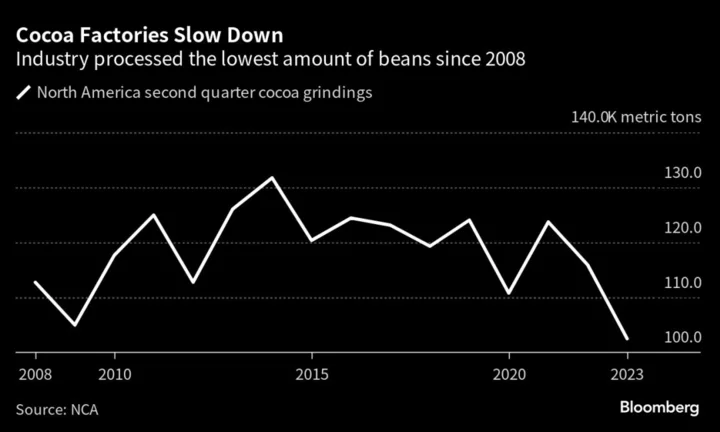Cocoa factories around the world are slowing down fast, a sign that the worst is still to come for chocolate makers.
Bean processing in North America slumped almost 12% in the second quarter, the lowest for that period since at least 2008. In Europe and Asia, factories ground the least cocoa since the global pandemic when lockdowns and reduced air travel curbed chocolate demand.
The figures spell trouble for the $117 billion global chocolate industry, which saw sales volume slip for the first time in six years in 2022, according to data from consumer research company Euromonitor International Plc. Factories are cutting back as high cocoa prices squeeze margins just as inflation hurts consumer pockets.
“The demand issues are multifold,” said Judy Ganes, president of consultancy J. Ganes Consulting, who has followed the market for more than 30 years. “There’s not just cocoa prices that are high, but sugar prices are also high, and manufacturers always look for ways to meet margins and work to put fewer chocolate chips in a cookie, or they shrink the bar sizes.”
Factories usually process cocoa several months before products are turned into chocolate. That means the slowdown likely signals the industry is expecting less demand ahead.
Barry Callebaut AG, the world’s largest marker of bulk chocolate, said earlier this month that its sales volume fell 2.7% in the first nine months of the year, with its gourmet and specialists business seeing the biggest drop.
Bean processing in North America slumped to 102,493 metric tons in the second, according to the National Confectioners Association. In Asia, grindings fell 6.5% and declined 5.7% in Europe, according to the Cocoa Association of Asia and the European Cocoa Association.
The disappointing data comes at a time when chocolate makers are contending with higher cocoa prices. Global inventories are at the lowest in almost three decades and an El Nino weather pattern threatens to plunge the world into a third year of shortages.
“The concern is that even with demand being guarded, production isn’t — production threats are likely greater,” Ganes said. “More than likely there’ll be a third consecutive deficit for next season.”
Cocoa futures traded in London, the industry benchmark, jumped 22% this year.
--With assistance from Mumbi Gitau.

